Application of Directed Energy Deposition-Based Additive Manufacturing in Repair
Abstract
1. Introduction
2. Directed Energy Deposition (DED)
3. Identified DED Capabilities in Repair
4. Industrial Case Studies
5. Conclusions
Author Contributions
Funding
Acknowledgments
Conflicts of Interest
References
- Leino, M.; Pekkarinen, J.; Soukka, R. The Role of Laser Additive Manufacturing Methods of Metals in Repair, Refurbishment and Remanufacturing—Enabling Circular Economy, Phys. Procedia 2016, 83, 752–760. [Google Scholar] [CrossRef]
- Fischedick, M.; Roy, J.; Abdel-aziz, A.; Acquaye, A.; Allwood, J.M.; Ceron, J.-P.; Geng, Y.; Kheshgi, H.; Lanza, A.; Perczyk, D.; et al. Climate Change 2014: Mitigation of Climate Change. Contribution of Working Group III to the Fifth Assessment Report of the Intergovernmental Panel on Climate Change; Cambridge University Press: New York, NY, USA, 2014. [Google Scholar]
- Comission, E. Closing the Loop—An EU Action Plan for the Circular Economy; European Commission: Brussels, Belgium, 2015. [Google Scholar]
- Saboori, A.; Gallo, D.; Biamino, S.; Fino, P.; Lombardi, M. An Overview of Additive Manufacturing of Titanium Components by Directed Energy Deposition: Microstructure and Mechanical Properties. Appl. Sci. 2017, 7, 883. [Google Scholar] [CrossRef]
- Levy, G.N.; Schindel, R.; Kruth, J.P. Rapid manufacturing and rapid tooling with layer manufacturing (LM) technologies, state of the art and future perspectives. Cirp Ann. 2003, 52, 589–609. [Google Scholar] [CrossRef]
- Shamsaei, N.; Yadollahi, A.; Bian, L.; Thompson, S.M. An overview of Direct Laser Deposition for additive manufacturing; Part II: Mechanical behavior, process parameter optimization and control. Addit. Manuf. 2015, 8, 12–35. [Google Scholar] [CrossRef]
- Acharya, R.; Das, S. Additive Manufacturing of IN100 Superalloy Through Scanning Laser Epitaxy for Turbine Engine Hot-Section Component Repair: Process Development, Modeling, Microstructural Characterization, and Process Control. Metall. Mater. Trans. A 2015, 46, 3864–3875. [Google Scholar] [CrossRef]
- Liang, Y.-J.; Liu, D.; Wang, H.-M. Microstructure and mechanical behavior of commercial purity Ti/Ti–6Al–2Zr–1Mo–1V structurally graded material fabricated by laser additive manufacturing. Scr. Mater. 2014, 74, 80–83. [Google Scholar] [CrossRef]
- Sames, W.J.; List, F.A.; Pannala, S.; Dehoff, R.R.; Babu, S.S. The metallurgy and processing science of metal additive manufacturing The metallurgy and processing science of metal additive manufacturing. Int. Mater. Rev. 2016, 61, 315–360. [Google Scholar] [CrossRef]
- Li, C.; Liu, Z.Y.; Fang, X.Y.; Guo, Y.B. Residual Stress in Metal Additive Manufacturing. Procedia CIRP 2018, 71, 348–353. [Google Scholar] [CrossRef]
- Bosio, F.; Saboori, A.; Lacagnina, A.; Librera, E.; de Chirico, M.; Biamino, S.; Fino, P.; Lombardi, M. Directed energy deposition of 316L steel: Effect of type of powders and gas related parameters. In Proceedings of the Euro PM2018 Congress Exhebition, Bilbao, Spain, 14–18 October 2018. [Google Scholar]
- Wang, J.; Prakash, S.; Joshi, Y.; Liou, F.W. Laser Aided Part Repair-A Review. In Solid Free. Fabr. Proc.; University of Texas Press: Austin, TX, USA, 2004. [Google Scholar]
- Wang, Z.-K.; Ye, H.-Q.; Xu, D.-S.; Huang, S.-Y. Laser repairing surface crack of Ni-based superalloy components. Trans. Nonferrous Met. Soc. China 2011, 11, 572–575. [Google Scholar]
- Díaz, E.; Amado, J.M.; Montero, J.; Tobar, M.J.; Yáñez, A. Comparative Study of Co-based Alloys in Repairing Low Cr-Mo steel Components by Laser Cladding. Phys. Procedia 2012, 39, 368–375. [Google Scholar] [CrossRef]
- Thompson, A.; Maskery, I.; Leach, K.R. X-ray computed tomography for additive manufacturing: A review. Meas. Sci. Technol. 2016, 27, 1–17. [Google Scholar] [CrossRef]
- Pinkerton, A.J.; Wang, W.; Li, L. Component repair using laser direct metal deposition. Proc. Inst. Mech. Eng. Part B J. Eng. Manuf. 2008, 222, 827–836. [Google Scholar] [CrossRef]
- King, A.M.; Burgess, S.C.; Ijomah, W.; McMahon, C.A. Reducing waste: Repair, recondition, remanufacture or recycle? Sustain. Dev. 2006, 14, 257–267. [Google Scholar] [CrossRef]
- Wilson, J.M.; Piya, C.; Shin, Y.C.; Zhao, F.; Ramani, K. Remanufacturing of turbine blades by laser direct deposition with its energy and environmental impact analysis. J. Clean. Prod. 2014, 80, 170–178. [Google Scholar] [CrossRef]
- Yushchenko, K.A.; Savchenko, V.S.; Chervyakova, L.V.; David, S.A.; Vitek, J.M. Study of Weldability and Development of the Technology for Repair of High-Nickel Alloy Components; Oak Ridge National Laboratory: Oak Ridge, TN, USA, 1943. [Google Scholar]
- Ramalho, A.L.; Ferreira, J.A.M.; Branco, C.A.G.M. Fatigue behaviour of T welded joints rehabilitated by tungsten inert gas and plasma dressing. Mater. Des. 2011, 32, 4705–4713. [Google Scholar] [CrossRef]
- Su, C.Y.; Chou, C.P.; Wu, B.C.; Lih, W.C. Plasma transferred arc repair welding of the nickel-base superalloy IN-738LC. J. Mater. Eng. Perform. 1997, 6, 619–627. [Google Scholar] [CrossRef]
- Bi, G.; Gasser, A. Restoration of Nickel-Base Turbine Blade Knife-Edges with Controlled Laser Aided Additive Manufacturing. Phys. Procedia 2011, 12, 402–409. [Google Scholar] [CrossRef]
- Darut, G.; Liao, H.; Coddet, C.; Bordes, J.M.; Diaby, M. Steel coating application for engine block bores by Plasma Transferred Wire Arc spraying process. Surf. Coat. Technol. 2015, 268, 115–122. [Google Scholar] [CrossRef]
- Tan, J.C.; Looney, L.; Hashmi, M.S.J. Component repair using HVOF thermal spraying. J. Mater. Process. Technol. 1999, 92, 203–208. [Google Scholar] [CrossRef]
- Aoshima, S. Electro-Spark Process for Repair and Maintenance of Die-Casting Dies; TechnoCoat Int.: Fujieda, Japan, 1999; pp. 1–3. [Google Scholar]
- Roy, T.; Abrahams, R.; Paradowska, A.; Lai, Q.; Mutton, P.; Soodi, M.; Fasihi, P.; Yan, W. Evaluation of the mechanical properties of laser cladded hypereutectoid steel rails. Wear 2019, 432–433, 202930. [Google Scholar] [CrossRef]
- Toyserkani, E.; Khajepour, A.; Corbin, S.F. Laser Cladding, 1st ed.; Taylor Francis Group: Boca Raton, FL, USA, 2004. [Google Scholar]
- Baufeld, B.; Brandl, E.; van der Biest, O. Wire based additive layer manufacturing: Comparison of microstructure and mechanical properties of Ti-6Al-4V components fabricated by laser-beam deposition and shaped metal deposition. J. Mater. Process. Tech. 2011, 211, 1146–1158. [Google Scholar] [CrossRef]
- Singh, H.; Jain, P.K. Past, present and future the characterization of surface topography of plasmatransferred arc coatings. In Proceedings of the Indian Conference on Applied Mechanics, New Delhi, India, 13–15 July 2015. [Google Scholar]
- Alberti, E.A.; Bueno, B.M.P.; D’Oliveira, A.S.C.M. Additive manufacturing using plasma transferred arc. Int. J. Adv. Manuf. Technol. 2016, 83, 1861–1871. [Google Scholar] [CrossRef]
- Ahn, D.-G. Direct metal additive manufacturing processes and their sustainable applications for green technology: A review. Int. J. Precis. Eng. Manuf. Green Technol. 2016, 3, 381–395. [Google Scholar] [CrossRef]
- Saboori, A.; Bosio, F.; Librera, E.; de Chirico, M.; Biamino, S.; Lombardi, M.; Fino, P. Accelerated Process Parameter Optimization for Directed Energy Deposition of 316L Stainless Steel. In Proceedings of the Euro PM2018 Congress Exhebition, Bilbao, Spain, 14–18 October 2018. [Google Scholar]
- Frazier, W.E. Metal Additive Manufacturing: A Review. J. Mater. Eng. Perform. 2014, 23, 1917–1928. [Google Scholar] [CrossRef]
- Torims, T. The Application of Laser Cladding to Mechanical Component Repair, Renovation and Regeneration. In DAAAM International Scientific Book 2013; DAAAM International: Vienna, Austria, 2013; pp. 587–602. [Google Scholar]
- Gibson, I.; Rosen, D.; Stucker, B. Directed Energy Deposition Processes. In Addit. Manuf. Technol. 3D Printing, Rapid Prototyping, Direct Digit. Manuf.; Springer: New York, NY, USA, 2015; pp. 245–268. [Google Scholar]
- Mazzucato, F.; Tusacciu, S.; Lai, M.; Biamino, S.; Lombardi, M.; Valente, A. Monitoring Approach to Evaluate the Performances of a New Deposition Nozzle Solution for DED Systems. Technologies 2017, 5, 29. [Google Scholar] [CrossRef]
- Li, Z.; Wei, M.; Xiao, K.; Bai, Z.; Xue, W.; Dong, C.; Wei, D.; Li, X. Microhardness and wear resistance of Al2O3-TiB2-TiC ceramic coatings on carbon steel fabricated by laser cladding. Ceram. Int. 2019, 45, 115–121. [Google Scholar] [CrossRef]
- Liu, Z.; Dong, Y.; Chu, Z.; Yang, Y.; Li, Y.; Yan, D. Corrosion behavior of plasma sprayed ceramic and metallic coatings on carbon steel in simulated seawater. Mater. Des. 2013, 52, 630–637. [Google Scholar] [CrossRef]
- Sun, W.; He, S.; Guo, G.; Zhao, H.; He, Z. Integration detection of maneuvering target in strong clutter background with high range resolution radar. Tien Tzu Hsueh Pao Acta Electron. Sin. 1998, 26, 12–15. [Google Scholar]
- Guo, G.F.; Chen, F.R.; Li, L.H. Application of laser cladding technology in surface modification of titanium alloys. Surf. Technol. 2006, 35, 66–69. [Google Scholar]
- Gao, C.; Xu, B. Advances in laser cladding ceramic particle reinforced metal mateix composite coating technology. Surf. Technol. 2008, 37, 63–66. [Google Scholar]
- Keist, J.S.; Palmer, T.A. Development of strength-hardness relationships in additively manufactured titanium alloys. Mater. Sci. Eng. A 2017, 693, 214–224. [Google Scholar] [CrossRef]
- Kumara, C.; Segerstark, A.; Hanning, F.; Dixit, N.; Joshi, S.; Moverare, J.; Nylén, P. Microstructure modelling of laser metal powder directed energy deposition of alloy 718. Addit. Manuf. 2019, 25, 357–364. [Google Scholar] [CrossRef]
- Saboori, A.; Tusacciu, S.; Busatto, M.; Lai, M.; Biamino, S.; Fino, P.; Lombardi, M. Production of Single Tracks of Ti-6Al-4V by Directed Energy Deposition to Determine the Layer Thickness for Multilayer Deposition. J. Vis. Exp. 2018, 2018, e56966. [Google Scholar] [CrossRef]
- de Lima, M.S.F.; Sankaré, S. Microstructure and mechanical behavior of laser additive manufactured AISI 316 stainless steel stringers. Mater. Des. 2014, 55, 526–532. [Google Scholar] [CrossRef]
- Dinda, G.P.; Dasgupta, A.K.; Mazumder, J. Laser aided direct metal deposition of Inconel 625 superalloy: Microstructural evolution and thermal stability. Mater. Sci. Eng. A 2009, 509, 98–104. [Google Scholar] [CrossRef]
- Lia, F.; Park, J.; Tressler, J.; Martukanitz, R. Partitioning of laser energy during directed energy deposition. Addit. Manuf. 2017, 18, 31–39. [Google Scholar] [CrossRef]
- Liu, J.; Yu, H.; Chen, C.; Weng, F.; Dai, J. Research and development status of laser cladding on magnesium alloys: A review. Opt. Lasers Eng. 2017, 93, 195–210. [Google Scholar] [CrossRef]
- Li, Y.; Zhang, P.; Bai, P.; Wu, L.; Liu, B.; Zhao, Z. Microstructure and properties of Ti/TiBCN coating on 7075 aluminum alloy by laser cladding. Surf. Coat. Technol. 2018, 334, 142–149. [Google Scholar] [CrossRef]
- Şimşir, M.; Kumruoğlu, L.C.; Özer, A. An investigation into stainless-steel/structural-alloy-steel bimetal produced by shell mould casting. Mater. Des. 2009, 30, 264–270. [Google Scholar] [CrossRef]
- Liu, L.; Zhuang, Z.; Liu, F.; Zhu, M. Additive manufacturing of steel--bronze bimetal by shaped metal deposition: Interface characteristics and tensile properties. Int. J. Adv. Manuf. Technol. 2013, 69, 2131–2137. [Google Scholar] [CrossRef]
- Gómez, X.; Echeberria, J. Microstructure and mechanical properties of carbon steel A210–superalloy Sanicro 28 bimetallic tubes. Mater. Sci. Eng. A 2003, 348, 180–191. [Google Scholar] [CrossRef]
- Liu, Z.H.; Zhang, D.Q.; Sing, S.L.; Chua, C.K.; Loh, L.E. Interfacial characterization of SLM parts in multi-material processing: Metallurgical diffusion between 316L stainless steel and C18400 copper alloy. Mater. Charact. 2014, 94, 116–125. [Google Scholar] [CrossRef]
- Bandyopadhyay, A.; Krishna, B.V.; Xue, W.; Bose, S. Application of Laser Engineered Net Shaping (LENS) to manufacture porous and functionally graded structures for load bearing implants. J. Mater. Sci. Mater. Med. 2008, 20, 29. [Google Scholar] [CrossRef]
- Al-Jamal, O.M.; Hinduja, S.; Li, L. Characteristics of the bond in Cu–H13 tool steel parts fabricated using SLM. CIRP Ann. 2008, 57, 239–242. [Google Scholar] [CrossRef]
- Guobin, L.; Jianjun, W.; Xiangzhi, L.; Guiyun, L. The properties and application of bi-metal hot-forging die. J. Mater. Process. Technol. 1998, 75, 152–156. [Google Scholar] [CrossRef]
- Nakano, J.; Miwa, Y.; Tsukada, T.; Kikuchi, M.; Kita, S.; Nemoto, Y.; Tsuji, H.; Jitsukawa, S. Characterization of 316L(N)-IG SS joint produced by hot isostatic pressing technique. J. Nucl. Mater. 2002, 307, 1568–1572. [Google Scholar] [CrossRef]
- Yilmaz, O.; Çelik, H. Electrical and thermal properties of the interface at diffusion-bonded and soldered 304 stainless steel and copper bimetal. J. Mater. Process. Technol. 2003, 141, 67–76. [Google Scholar] [CrossRef]
- Durgutlu, A.; Okuyucu, H.; Gulenc, B. Investigation of effect of the stand-off distance on interface characteristics of explosively welded copper and stainless steel. Mater. Des. 2008, 29, 1480–1484. [Google Scholar] [CrossRef]
- Xiong, B.; Cai, C.; Wan, H.; Lu, B. Fabrication of high chromium cast iron and medium carbon steel bimetal by liquid–solid casting in electromagnetic induction field. Mater. Des. 2011, 32, 2978–2982. [Google Scholar] [CrossRef]
- Krishna, B.V.; Venugopal, P.; Rao, K.P. Co-extrusion of dissimilar sintered P/M preforms—An explored route to produce bimetallic tubes. Mater. Sci. Eng. A 2005, 407, 77–83. [Google Scholar] [CrossRef]
- Baufeld, B.; van der Biest, O.; Gault, R.; Ridgway, K. Manufacturing Ti-6Al-4V components by shaped metal deposition: Microstructure and mechanical properties. IOP Conf. Ser. Mater. Sci. Eng. 2011, 26, 12001. [Google Scholar] [CrossRef]
- Onuike, B.; Bandyopadhyay, A. Additive manufacturing of Inconel 718—Ti6Al4V bimetallic structures. Addit. Manuf. 2018, 22, 844–851. [Google Scholar] [CrossRef]
- Sahasrabudhe, H.; Harrison, R.; Carpenter, C.; Bandyopadhyay, A. Stainless steel to titanium bimetallic structure using LENSTM. Addit. Manuf. 2015, 5, 1–8. [Google Scholar] [CrossRef]
- Onuike, B.; Heer, B.; Bandyopadhyay, A. Additive manufacturing of Inconel 718—Copper alloy bimetallic structure using laser engineered net shaping (LENSTM). Addit. Manuf. 2018, 21, 133–140. [Google Scholar] [CrossRef]
- Seltzer, D.; Wang, X.; Nassar, A.; Schaino, J.; Reutzal, E. System Identification and Feedback Control for Directed-Energy Metal-Based Additive Manufacturing. In Proceedings of the Solid Freeform Fabrication Proceedings, Austin, TX, USA, 10–12 August 2015. [Google Scholar]
- Reutzel, E.W.; Nassar, A.R. A Survey of Sensing and Control Systems for Machine and Process Monitoring of Directed-Energy, Metal-Based Additive Manufacturing. Rapid Prototyp. J. 2015, 21, 159–167. [Google Scholar] [CrossRef]
- Camp, J.D.; Bergan, P. Implementation of Laser Repair Process for Navy Aluminum Components. In Proceedings of the Diminishing Manufacturing Sources and Material Shortages Conference, Phoenix, AZ, USA, 2–5 December 2019. [Google Scholar]
- Bremer, C. Adaptive Welding Strategies for Repair and Overhaul of Turbine Blades and Blisks. In Proceedings of the 3rd LANE, Laser Assisted Net Shape Engineering 3, Erlangen, Germany, 28–31 August 2001. [Google Scholar]
- Stefan, K. An Advanced Repair Technique: Laser Powder Build-up Welding. Sulzer Tech. Rev. 2001, 83, 4–6. [Google Scholar]
- Kistler, N.A.; Corbin, D.J.; Nassar, A.R.; Reutzel, E.W.; Beese, M.A. Effect of processing conditions on the microstructure, porosity, and mechanical properties of Ti-6Al-4V repair fabricated by directed energy deposition. J. Mater. Process. Technol. 2019, 264, 172–181. [Google Scholar] [CrossRef]
- Liu, Q.; Wang, Y.; Zheng, H.; Tang, K.; Li, H.; Gong, S. TC17 titanium alloy laser melting deposition repair process and properties. Opt. Laser Technol. 2016, 82, 1–9. [Google Scholar] [CrossRef]
- Kumar, L.J.; Nair, C.G.K. Laser metal deposition repair applications for Inconel 718 alloy. Mater. Today Proc. 2017, 4, 11068–11077. [Google Scholar] [CrossRef]
- da Sun, S.; Liu, Q.; Brandt, M.; Janardhana, M.; Clark, G. Microstructure and mechanical properties of laser cladding repair of aisi 4340 steel. In Proceedings of the 28th International Congress of the Aeronautical Sciences, Brisbane, Australia, 23–28 September 2012. [Google Scholar]
- Griffith, M.L. Understanding the microstructure and properties of components fabricated by laser engineered net shaping (LENSTM). Mat. Res. Soc. Symp. Proc. 2000, 625. [Google Scholar] [CrossRef]
- Zhu, S.; Chen, W.; Zhan, X.; Ding, L.; Zhou, J. Parameter optimisation of laser cladding repair for an Invar alloy mould. Proc. Inst. Mech. Eng. Part B: J. Eng. Manuf. 2018. [Google Scholar] [CrossRef]
- Yu, J.-H.; Choi, Y.-S.; Shim, D.-S.; Park, S.-H. Repairing casting part using laser assisted additive metal-layer deposition and its mechanical properties. Opt. Laser Technol. 2018, 106, 87–93. [Google Scholar] [CrossRef]
- Kattire, P.; Paul, S.; Singh, R.; Yan, W. Experimental characterization of laser cladding of CPM 9V on H13 tool steel for die repair applications. J. Manuf. Process. 2015, 20, 492–499. [Google Scholar] [CrossRef]
- Paydas, H.; Mertens, A.; Carrus, R.; Lecomte-Beckers, J.; Tchuindjang, J.T. Laser cladding as repair technology for Ti-6Al-4V alloy: Influence of building strategy on microstructure and hardness. Mater. Des. 2015, 85, 497–510. [Google Scholar] [CrossRef]
- Onuike, B.; Bandyopadhyay, A. Additive manufacturing in repair: Influence of processing parameters on properties of Inconel 718. Mater. Lett. 2019, 252, 256–259. [Google Scholar] [CrossRef]
- Borrego, L.P.; Pires, J.T.B.; Costa, J.M.; Ferreira, J.M. Mould steels repaired by laser welding. Eng. Fail. Anal. 2009, 16, 596–607. [Google Scholar] [CrossRef]
- Grum, J.; Slabe, J.M. Possibility of introducing laser surfacing into maintenance service of die-casting dies. Surf. Coat. Technol. 2004, 180, 596–602. [Google Scholar] [CrossRef]
- Clare, A.T.; Oyelola, O.; Abioye, T.E.; Farayibi, P.K. Laser cladding of rail steel with Co–Cr. Surf. Eng. 2013, 29, 731–736. [Google Scholar] [CrossRef]
- Leunda, J.; Soriano, C.; Sanz, C.; Navas, V.G. Laser Cladding of Vanadium-Carbide Tool Steels for Die Repair. Phys. Procedia 2011, 12, 345–352. [Google Scholar] [CrossRef]
- van Rooyen, C.; Burger, H.; Theron, M.; Doubell, P. In-situ Crack Repair by Laser Cladding. In Proceedings of the Fifth Int. WLT-Conference Lasers Manuf, Munich, Germany, 15–18 June 2009. [Google Scholar]
- Koehler, H.; Partes, K.; Seefeld, T.; Vollertsen, F. Laser reconditioning of crankshafts: From lab to application. Phys. Procedia 2010, 5, 387–397. [Google Scholar] [CrossRef]
- Mudge, R.P.; Wald, N.R. Laser Engineered Net Shaping Advances Additive Manufacturing and Repair. Weld. J. N. Y. 2007, 86, 44. [Google Scholar]
- Available online: https://www.kimi-sa.com/marine/diesel-engine-machinery/four-stroke-piston-repair (accessed on 1 July 2019).
- Bendeich, P.; Alam, N.; Brandt, M.; Carr, D.; Short, K.; Blevins, R.; Curfs, C.; Kirstein, O.; Atkinson, G.; Holden, T.; et al. Residual stress measurements in laser clad repaired low pressure turbine blades for the power industry. Mater. Sci. Eng. A 2006, 437, 70–74. [Google Scholar] [CrossRef]
- Rottwinkel, B.; Nölke, C.; Kaierle, S.; Wesling, V. Crack Repair of Single Crystal Turbine Blades Using Laser Cladding Technology. Procedia CIRP 2014, 22, 263–267. [Google Scholar] [CrossRef]
- Yilmaz, O.; Gindy, N.; Gao, J. A repair and overhaul methodology for aeroengine components. Robot. Comput. Integr. Manuf. 2010, 26, 190–201. [Google Scholar] [CrossRef]
- Pleterski, M.; Tušek, J.; Kosec, L.; Muhič, M.; Muhič, T. Laser Repair welding of molds with various pulse shapes. Metalurgija 2010, 49, 41–44. [Google Scholar]
- Persson, A.; Hogmark, S.; Bergström, J. Thermal fatigue cracking of surface engineered hot work tool steels. Surf. Coat. Technol. 2005, 191, 216–227. [Google Scholar] [CrossRef]
- Jhavar, S.; Paul, C.P.; Jain, N.K. Causes of failure and repairing options for dies and molds: A review. Eng. Fail. Anal. 2013, 34, 519–535. [Google Scholar] [CrossRef]
- Sun, Y.; Hanaki, S.; Uchida, H.; Sunada, H.; Tsujii, N. Repair effect of hot work tool steel by laser-melting process. J. Mater. Sci. Technol. 2003, 19, 91–93. [Google Scholar]
- Ebara, R.; Kubota, K. Failure analysis of hot forging dies for automotive components. Eng. Fail. Anal. 2008, 15, 881–893. [Google Scholar] [CrossRef]
- Lewis, S.R.; Lewis, R.; Fletcher, D.I. Assessment of laser cladding as an option for repairing/enhancing rails. Wear 2015, 330, 581–591. [Google Scholar] [CrossRef]
- Liu, X.; Zhang, K.; Li, M. Laser Cladding Device for In Situ Repairs of Marine Crankshafts. Adv. Mater. Res. 2013, 712, 709–714. [Google Scholar] [CrossRef]
- Kaierle, S.; Overmeyer, L.; Alfred, I.; Rottwinkel, B.; Hermsdorf, J.; Wesling, V.; Weidlich, N. Single-crystal turbine blade tip repair by laser cladding and remelting. CIRP J. Manuf. Sci. Technol. 2017, 19, 196–199. [Google Scholar] [CrossRef]
- Zhang, X.; Li, W.; Cui, W.; Liou, F. Modeling of worn surface geometry for engine blade repair using Laser-aided Direct Metal Deposition process. Manuf. Lett. 2018, 15, 1–4. [Google Scholar] [CrossRef]
- Nowotny, S.; Scharek, S.; Beyer, E.; Richter, K.-H. Laser Beam Build-Up Welding: Precision in Repair, Surface Cladding, and Direct 3D Metal Deposition. J. Therm. Spray Technol. 2007, 16, 344–348. [Google Scholar] [CrossRef]
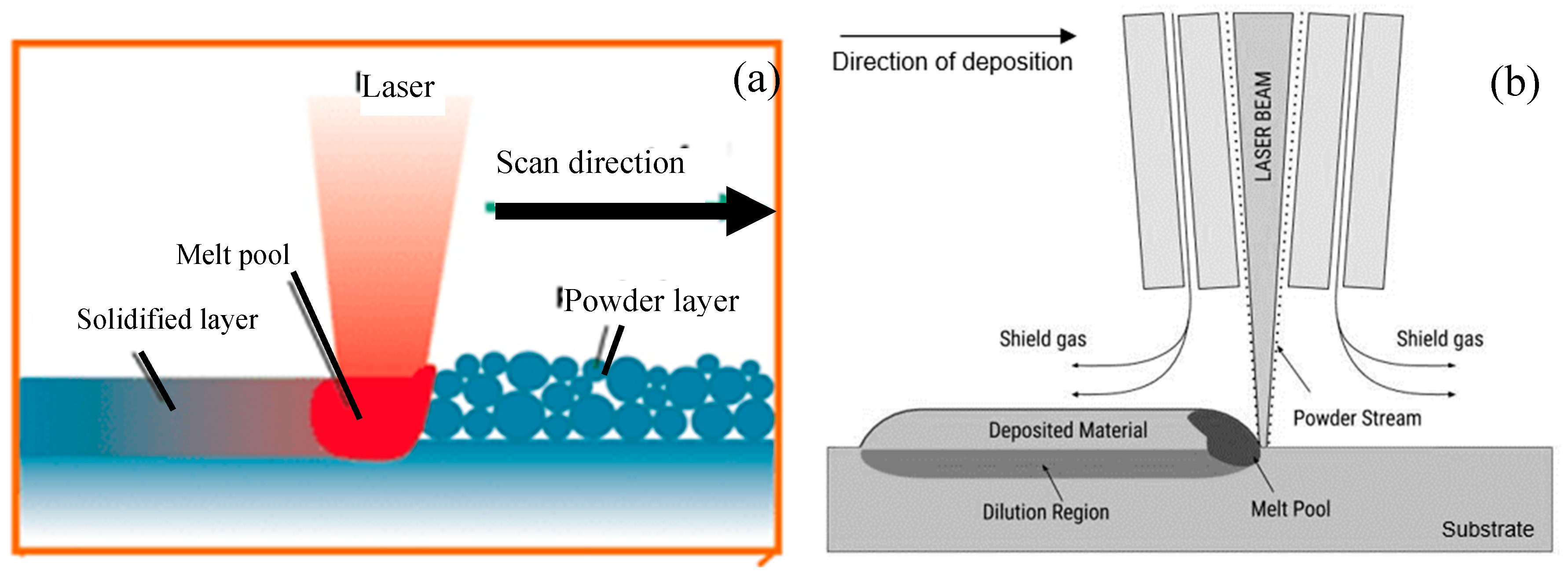
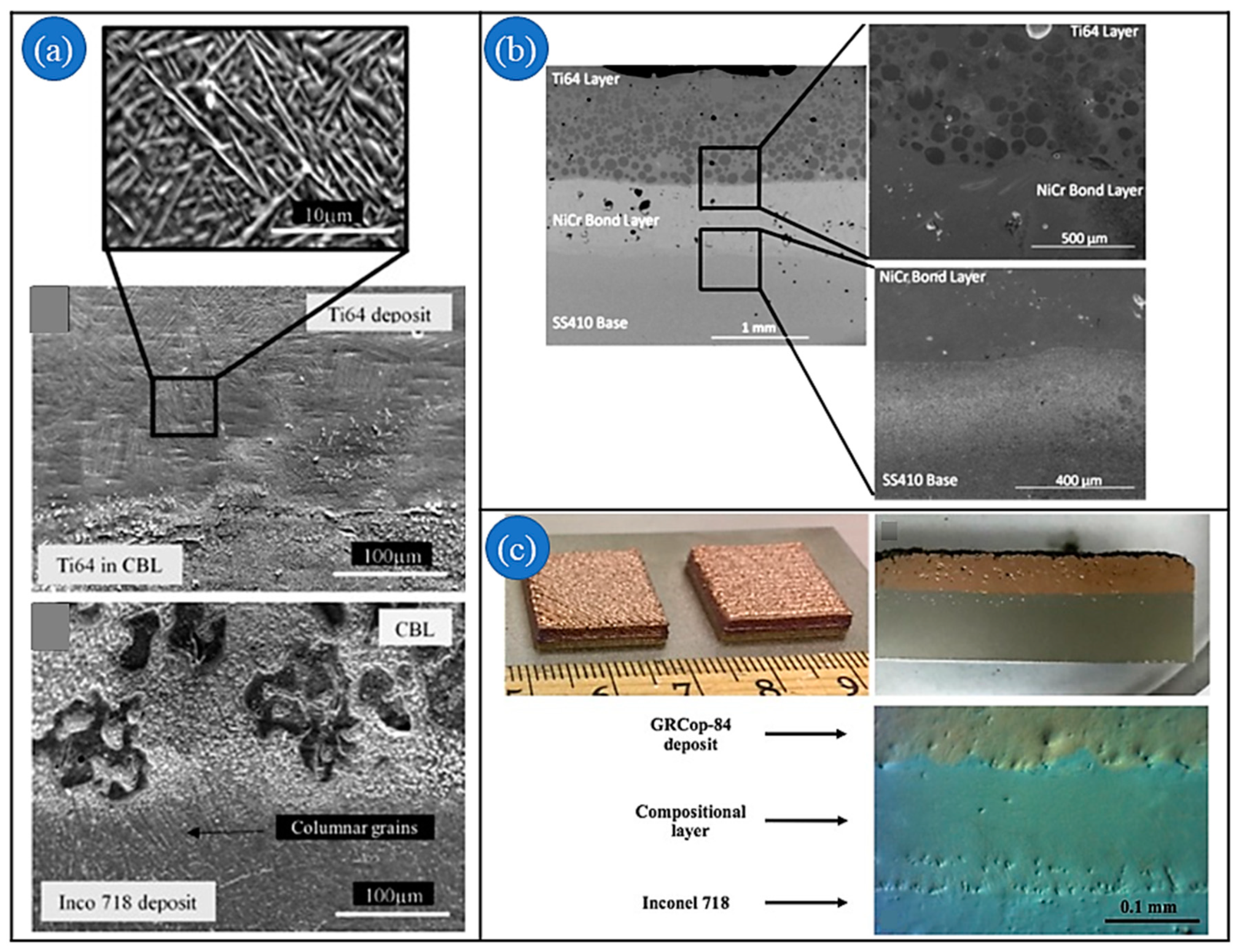

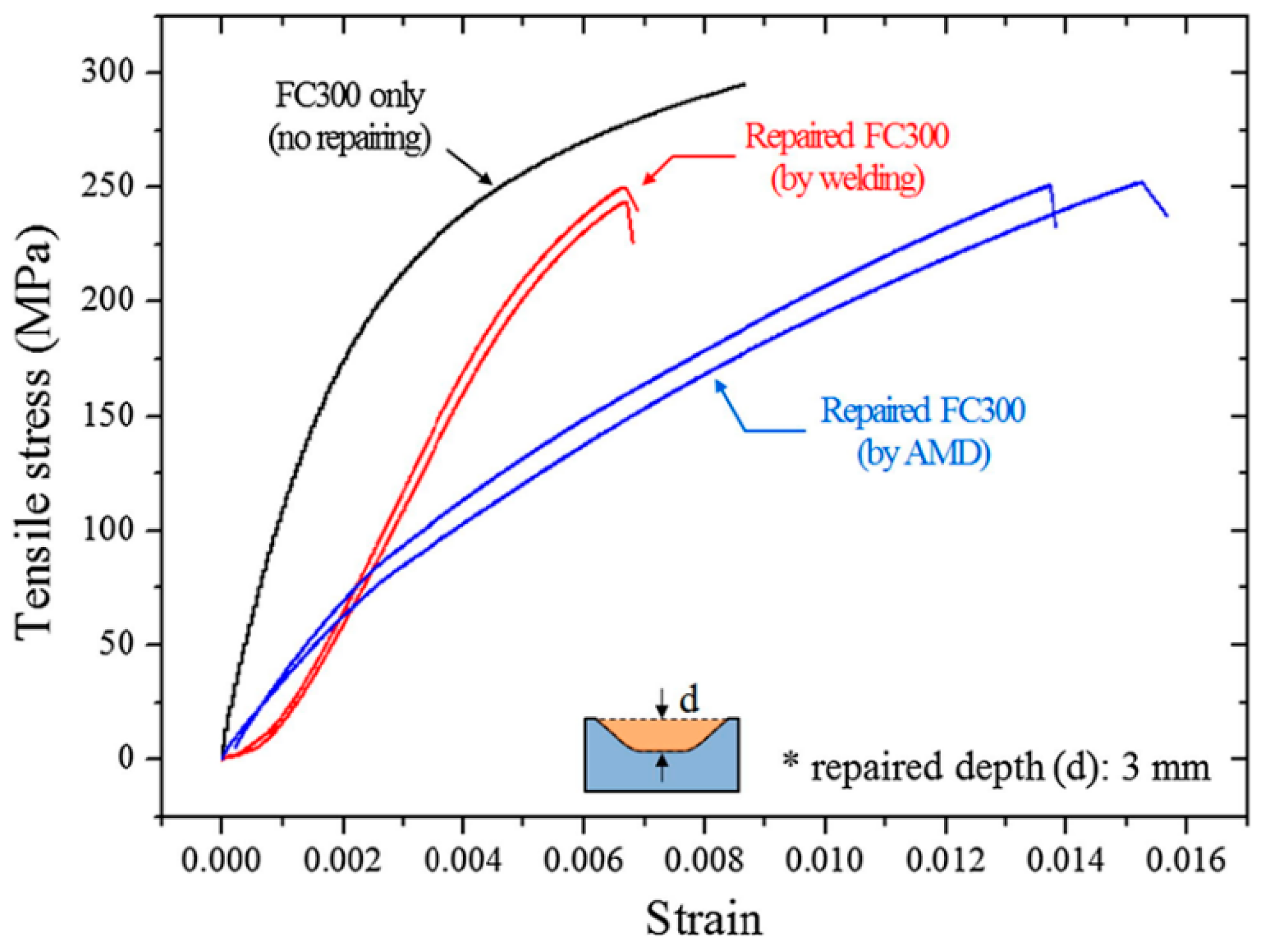
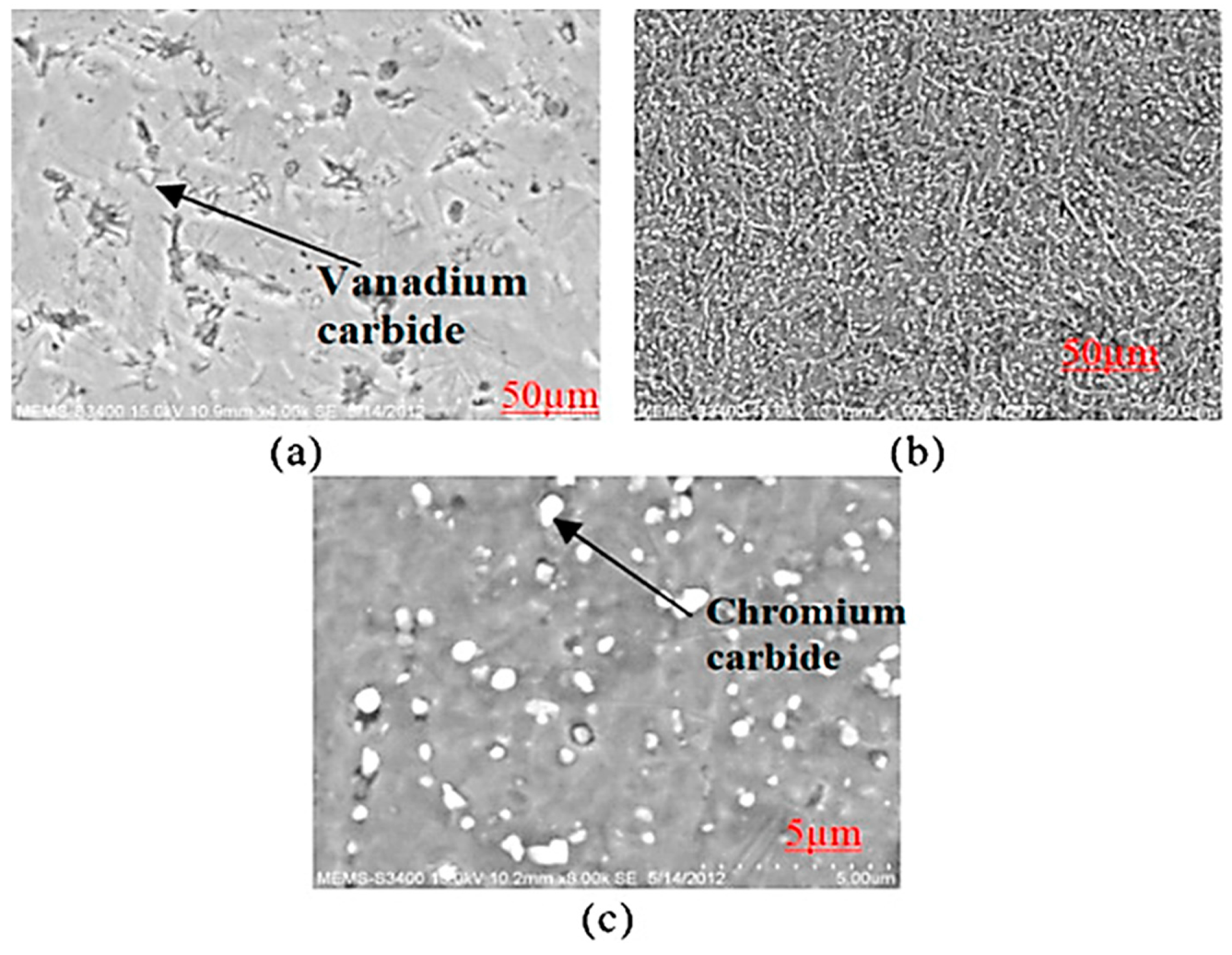
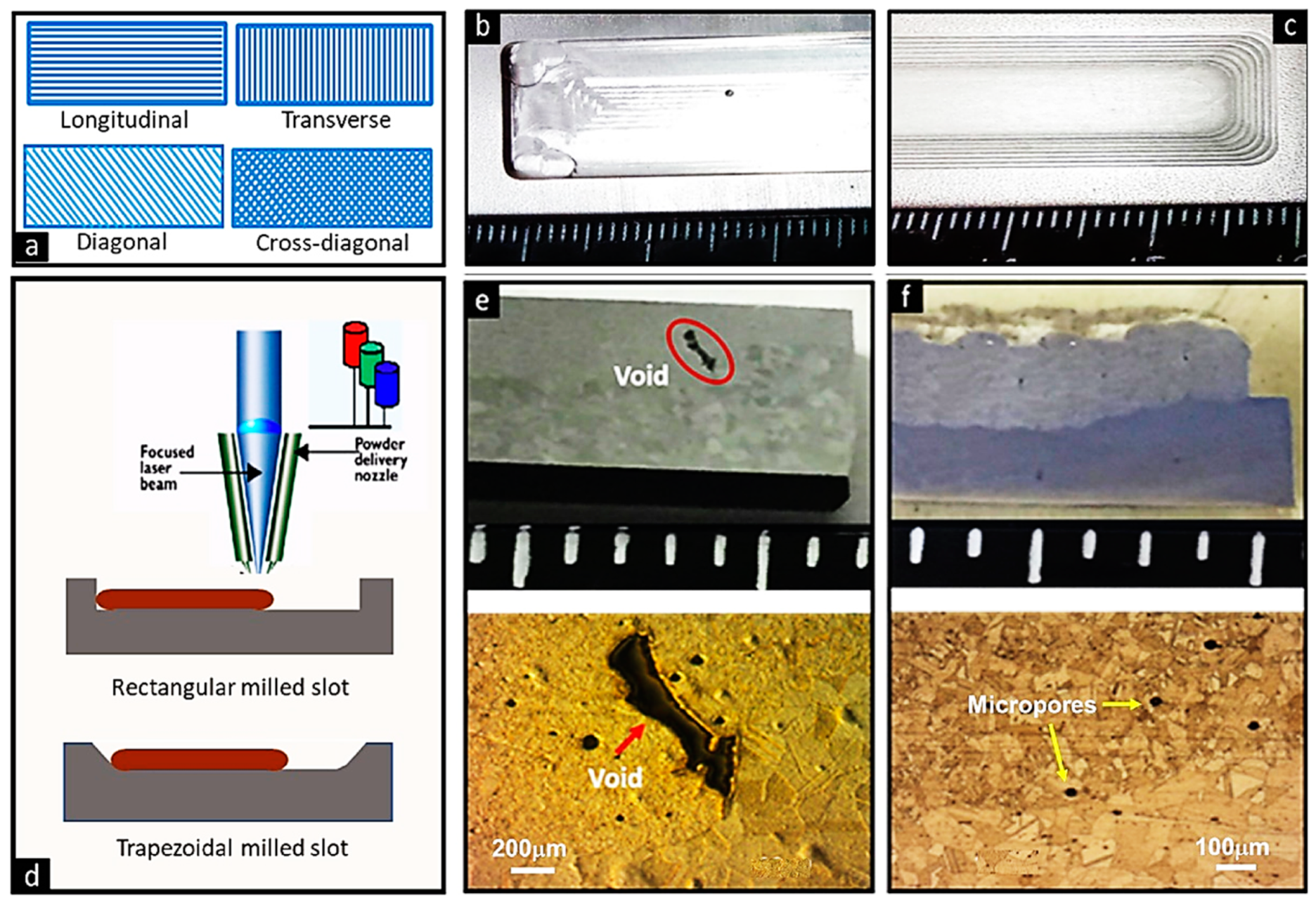
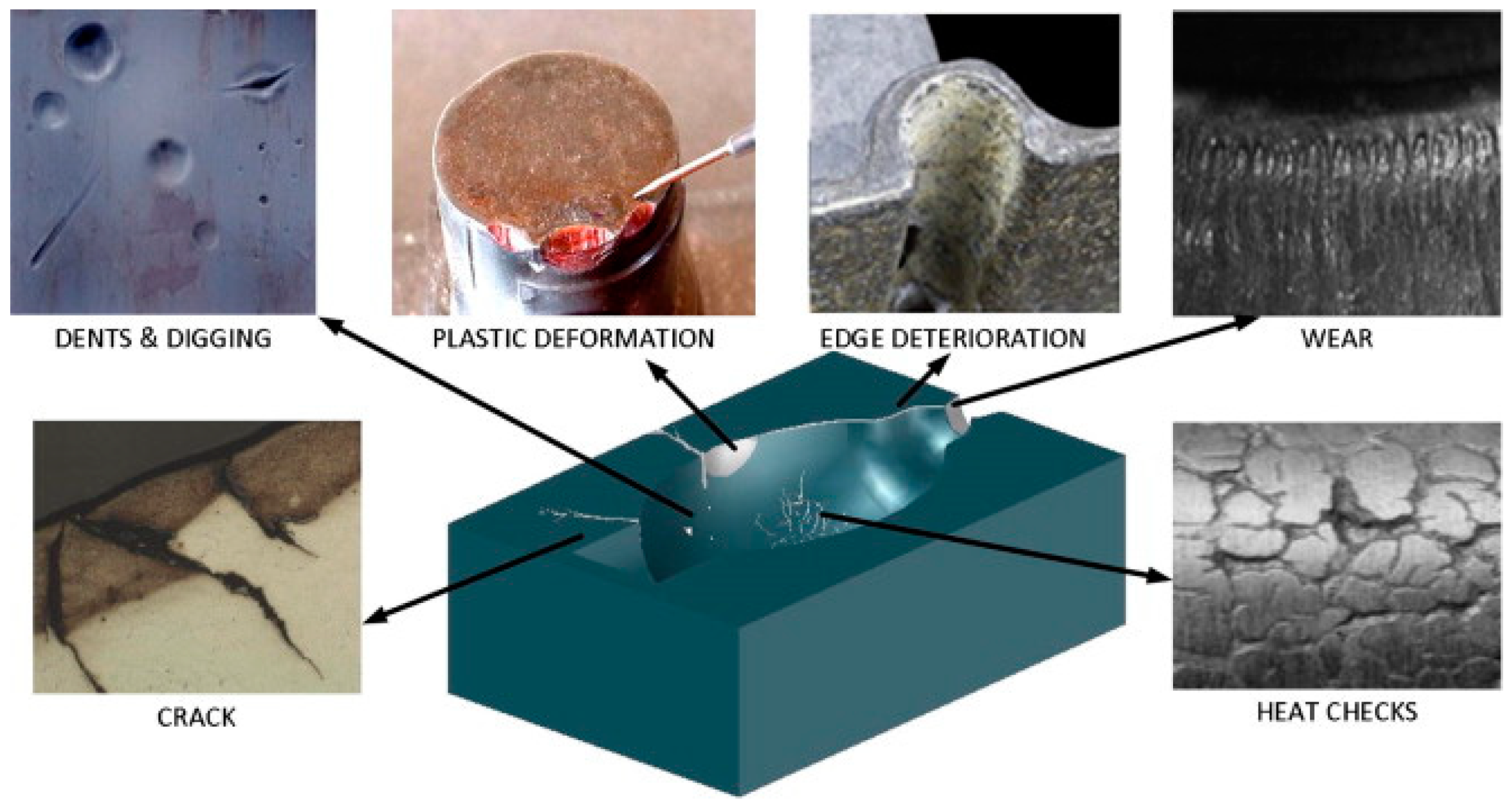
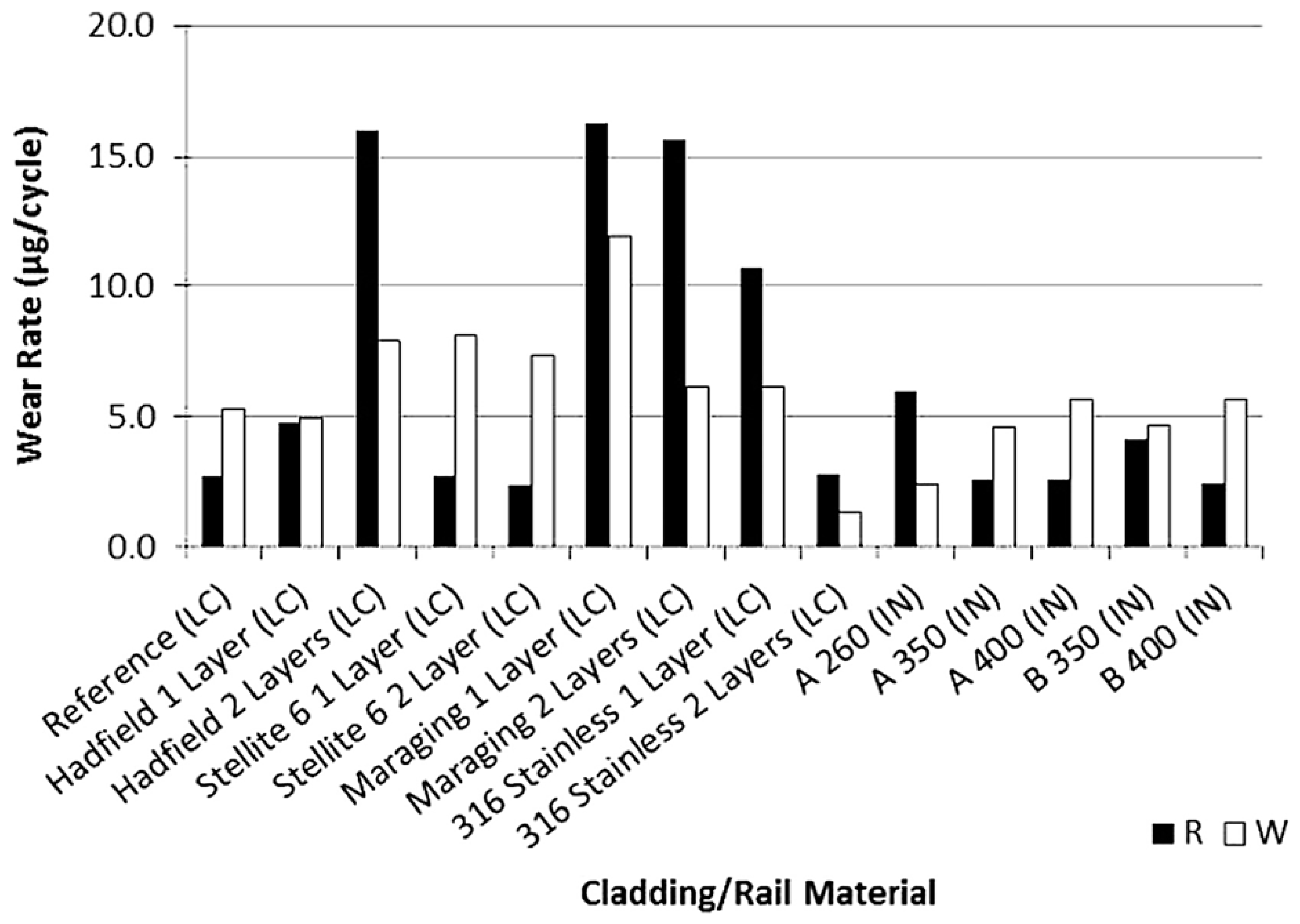
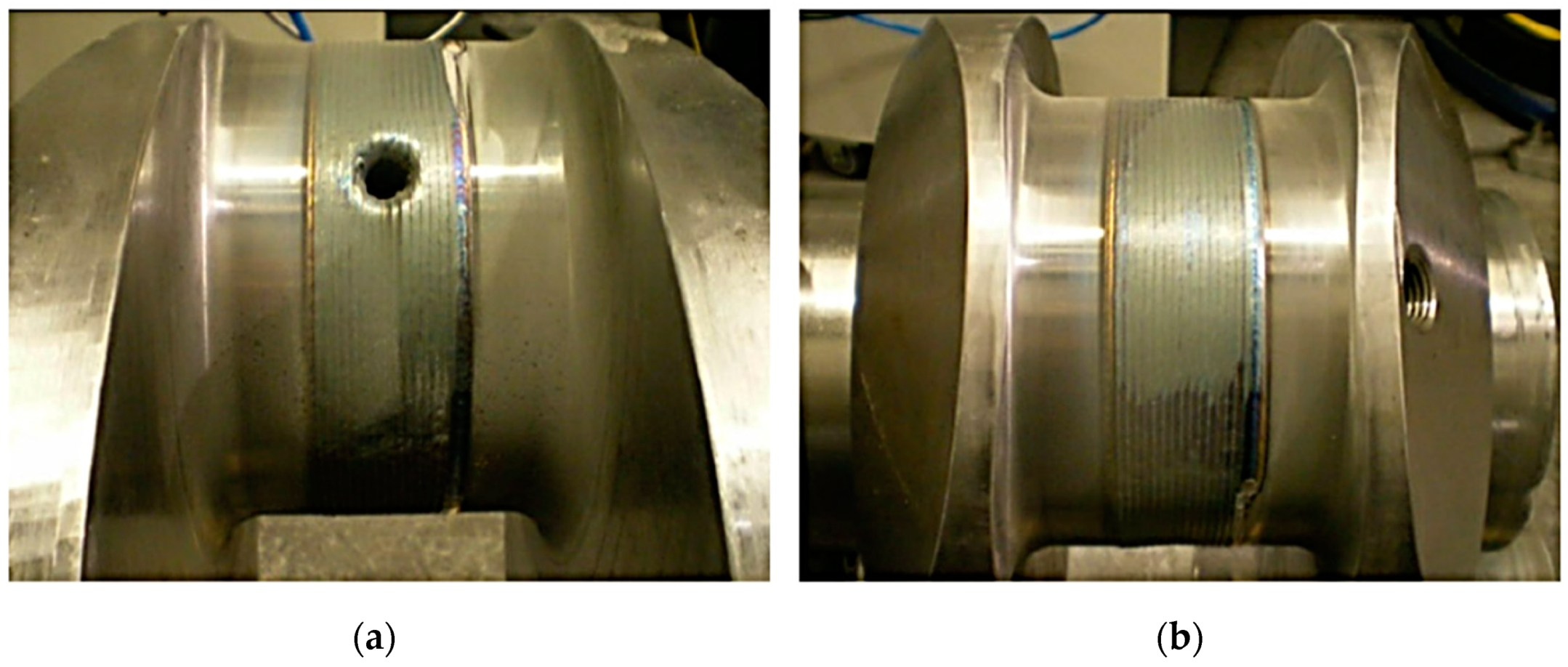
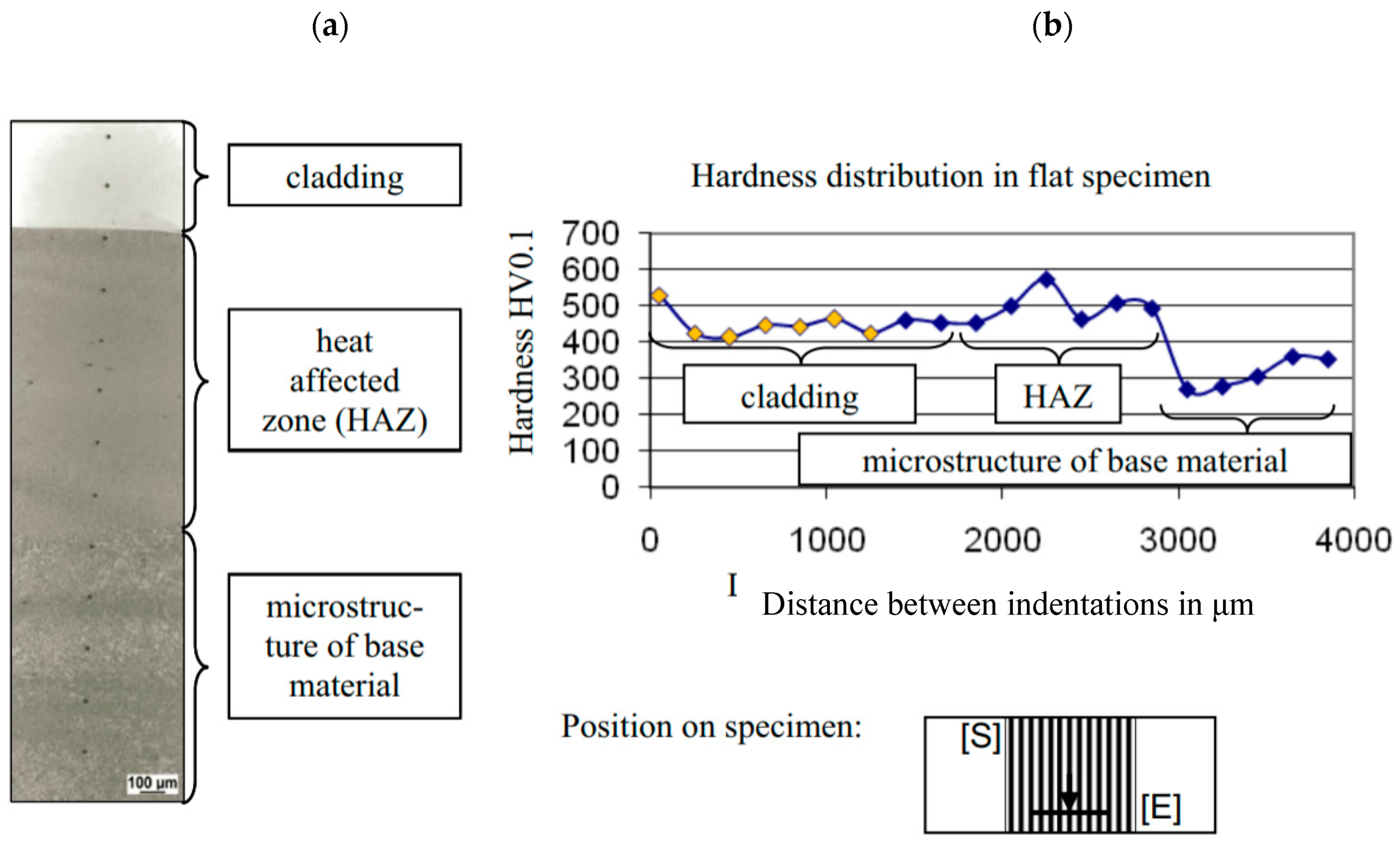


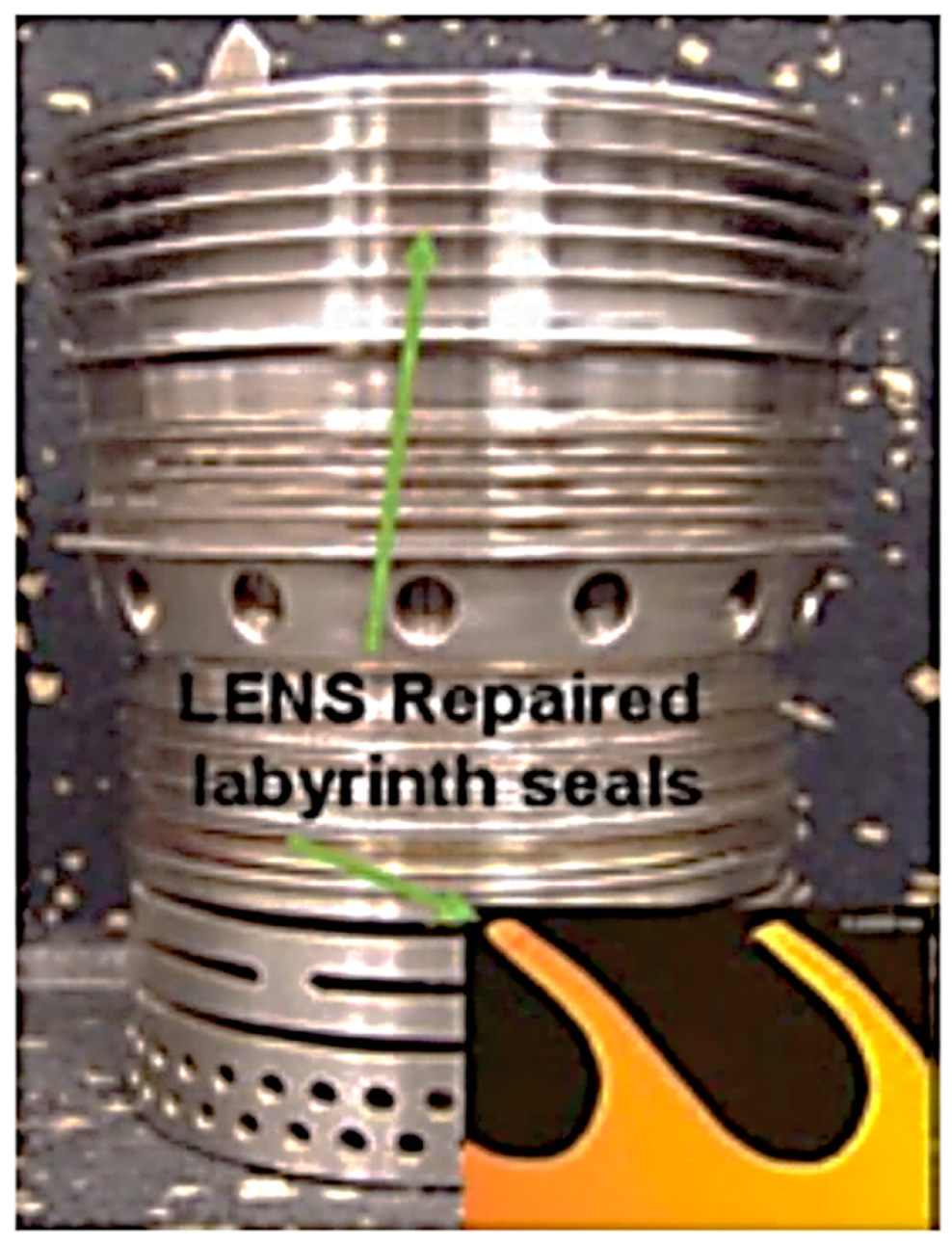
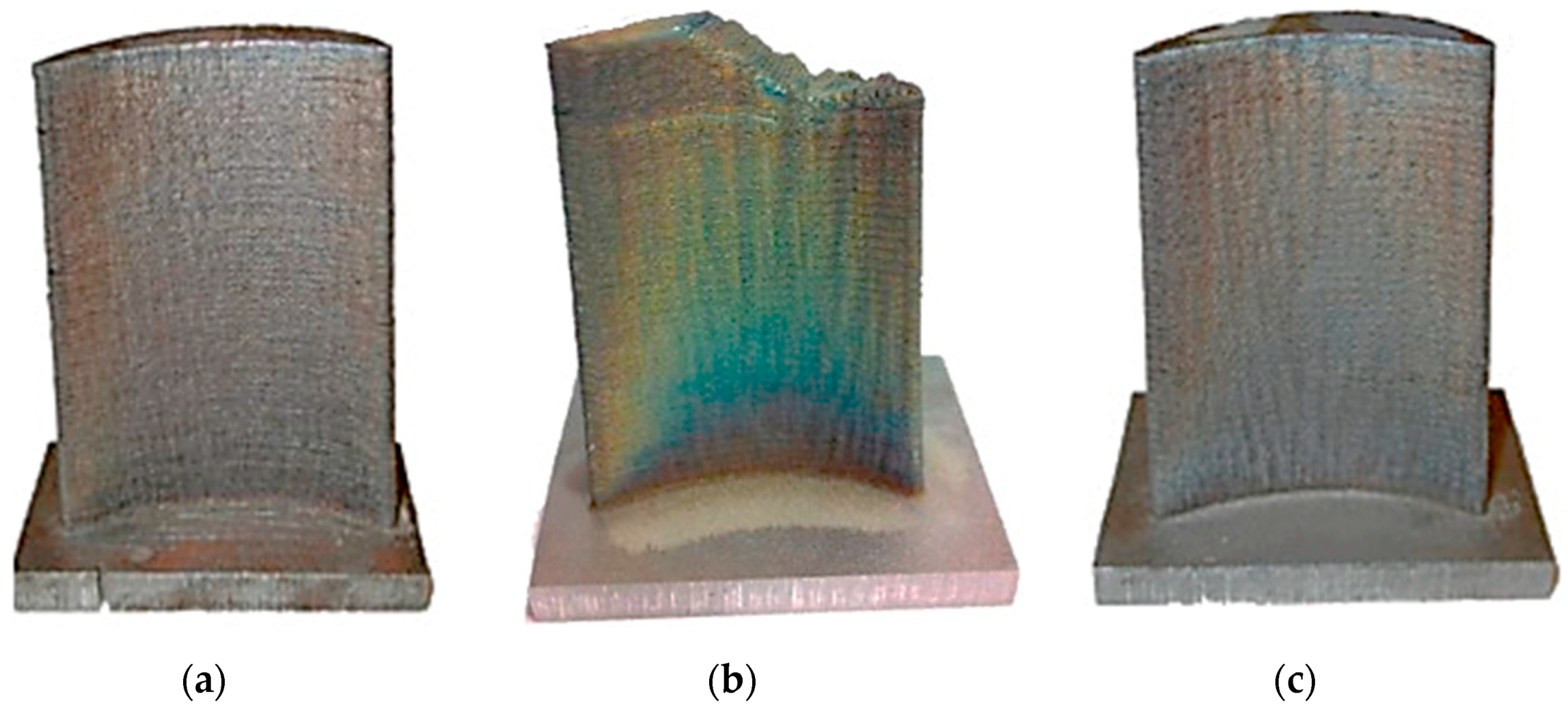
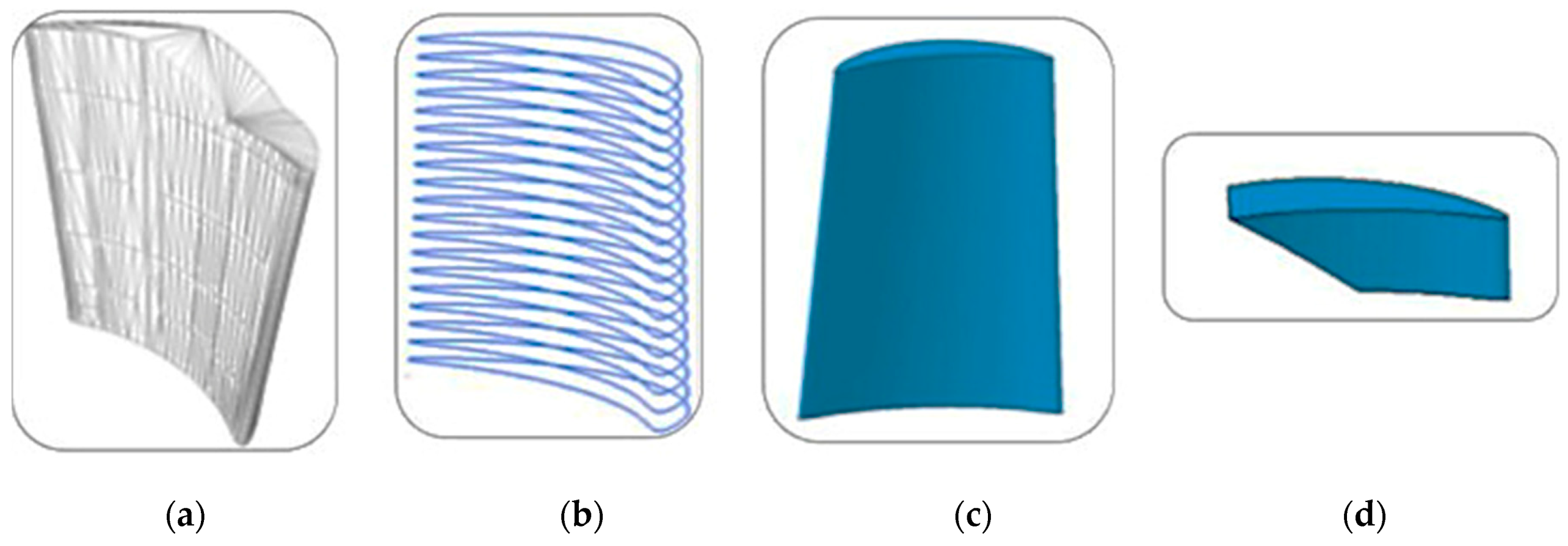
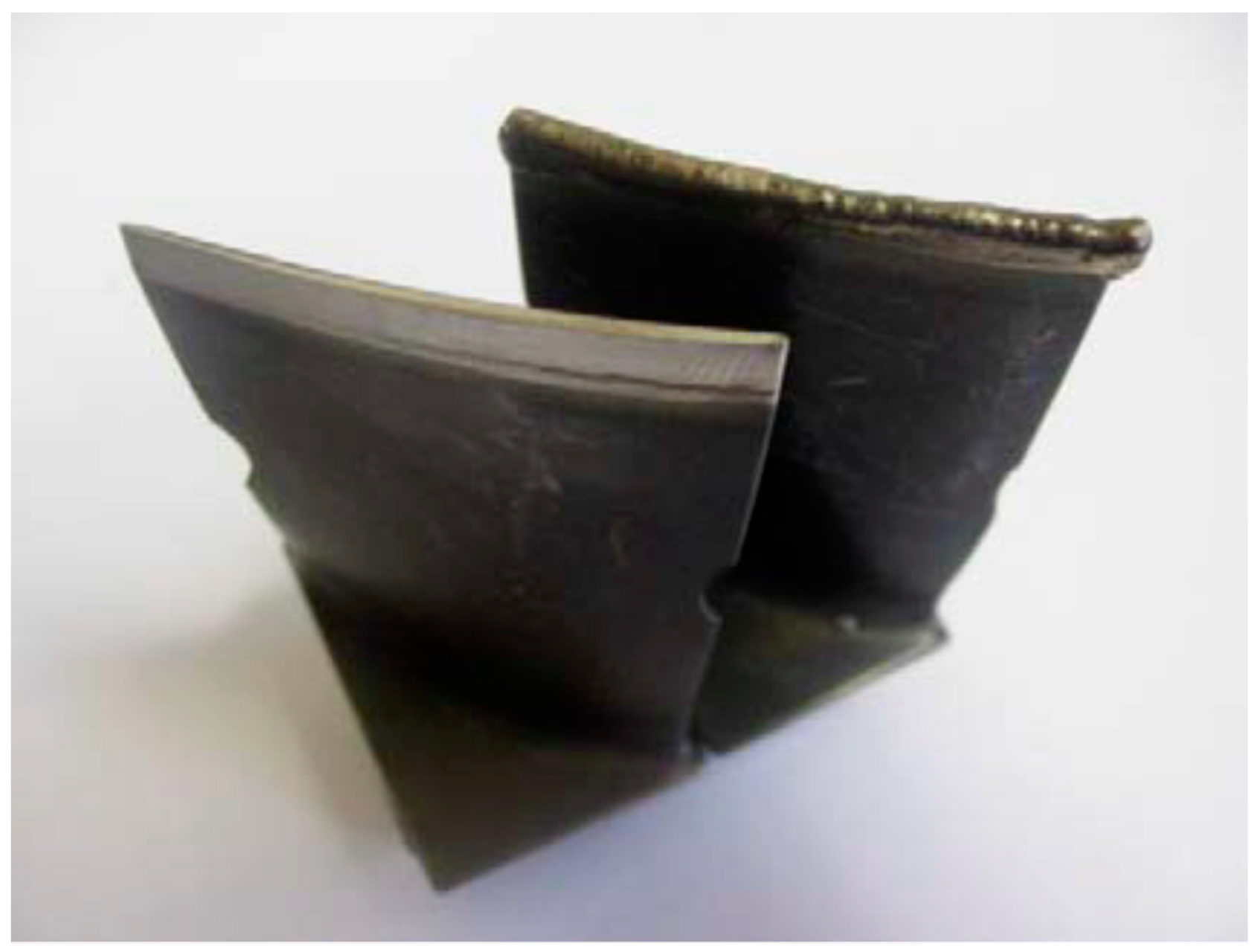
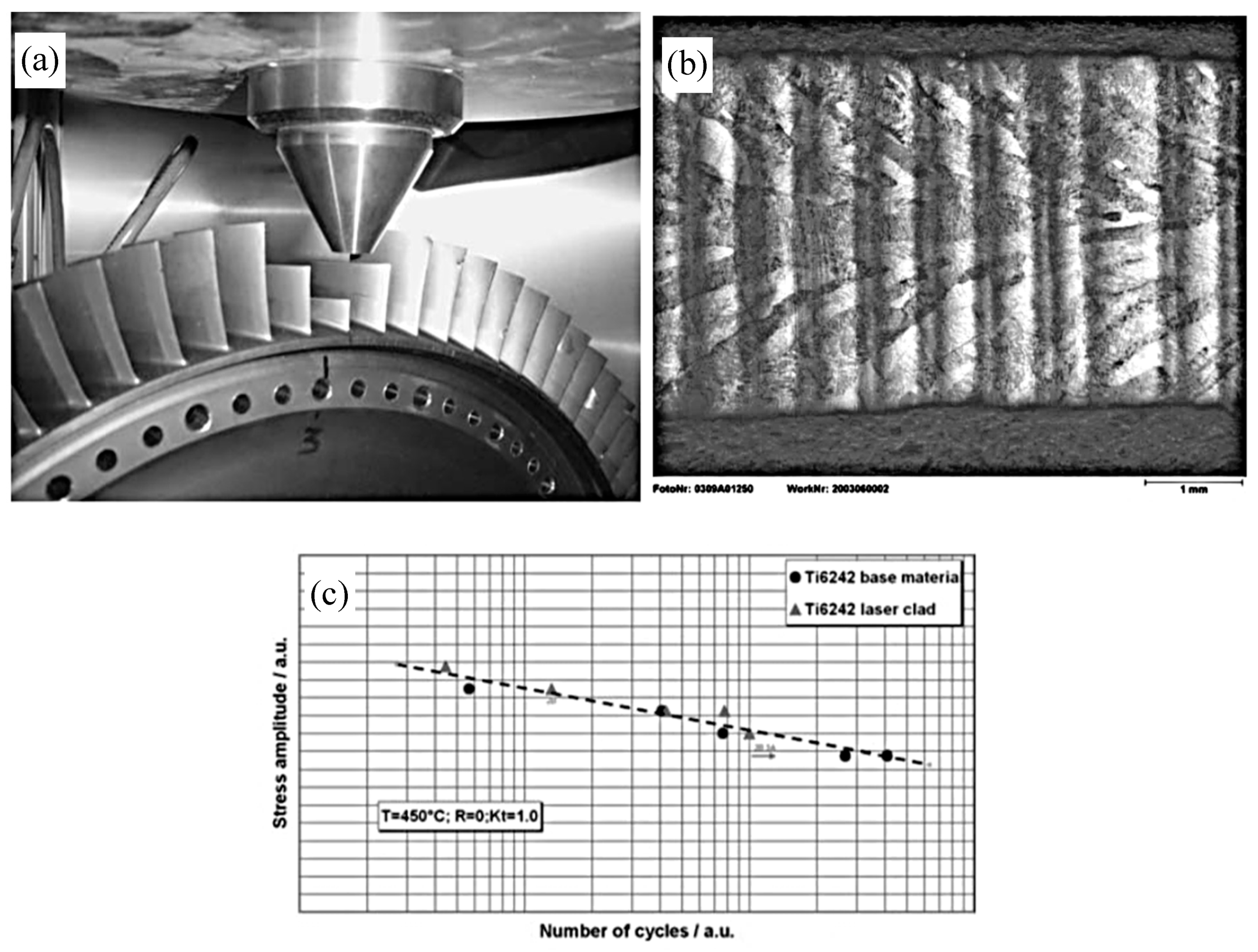
| Process | Post-Processing | Advantage | Disadvantage | Ref. |
|---|---|---|---|---|
| GTAW/TIG |
|
|
| [21,22] |
| Electro Spark |
|
|
| [25] |
| HVOF |
|
|
| [23,24] |
| Laser-based processes, such as DED |
|
|
| [26,27,28] |
| PTAW |
|
|
| [29,30] |
| Type of Repair | Repairing Corroded Steam Generator [12] | High-Value Al Parts That Underwent Wear [68] | Steel Molds That Underwent Wear [69] | Corroded Gas Turbine Blade [70] |
|---|---|---|---|---|
| Laser | 1000 W, CO2 | 1.0 KW, YAG | CO2 | N/A |
| Materials | NA | Al alloy | Tool steel | IN 738 |
| Gas | He | Ar or He | Ar or He | Ar |
| Control | Operated through an umbilical cord from a trailer by an operator using commands to a computer, which calculated the angles and position of each axis of the arm. | A six-axis assembly robot, which had special end-of-arm robotic tooling, containing the laser lens, powder tube, inert gas tube, and fume elimination system as a single unit | N/A | N/A |
| System arrangement | A six-axis robotic arm was used along with cameras for position detection and non-destructive examination sensors | A special fixture table was designed for fixing and rotating shells | N/A | The 3D digitizing system was used to create a 3D model of the components |
| Process | UTS (MPa) | YS (MPa) | Ε (%) | Ref. |
|---|---|---|---|---|
| Annealed bar | 841 | 403 | 30 | [75] |
| DED as-Build | 815 | 487 | 69 | [18] |
| Repair by DED | 793 | 482 | 56 | [18] |
| Component | Material | Ref. |
|---|---|---|
| Mold, Die, Tools | Steel | [78,81,82] |
| Rails | Steel | [83,84] |
| Vessels | Steel | [85] |
| Crankshaft | Steel | [86] |
| Driveshaft | Steel | [87] |
| Marin piston | Steel | [88] |
| Gas turbine compressor seal | Ni-based superalloy | [87] |
| Low-pressure turbine blades | Ni-based superalloy | [89] |
| Turbine airfoils | Ni-based superalloys | [18] |
| High-pressure single-crystal turbine blades | Ni-based superalloys | [90] |
| Thin-curved compressor blade | Ni-based superalloys | [91] |
© 2019 by the authors. Licensee MDPI, Basel, Switzerland. This article is an open access article distributed under the terms and conditions of the Creative Commons Attribution (CC BY) license (http://creativecommons.org/licenses/by/4.0/).
Share and Cite
Saboori, A.; Aversa, A.; Marchese, G.; Biamino, S.; Lombardi, M.; Fino, P. Application of Directed Energy Deposition-Based Additive Manufacturing in Repair. Appl. Sci. 2019, 9, 3316. https://doi.org/10.3390/app9163316
Saboori A, Aversa A, Marchese G, Biamino S, Lombardi M, Fino P. Application of Directed Energy Deposition-Based Additive Manufacturing in Repair. Applied Sciences. 2019; 9(16):3316. https://doi.org/10.3390/app9163316
Chicago/Turabian StyleSaboori, Abdollah, Alberta Aversa, Giulio Marchese, Sara Biamino, Mariangela Lombardi, and Paolo Fino. 2019. "Application of Directed Energy Deposition-Based Additive Manufacturing in Repair" Applied Sciences 9, no. 16: 3316. https://doi.org/10.3390/app9163316
APA StyleSaboori, A., Aversa, A., Marchese, G., Biamino, S., Lombardi, M., & Fino, P. (2019). Application of Directed Energy Deposition-Based Additive Manufacturing in Repair. Applied Sciences, 9(16), 3316. https://doi.org/10.3390/app9163316










